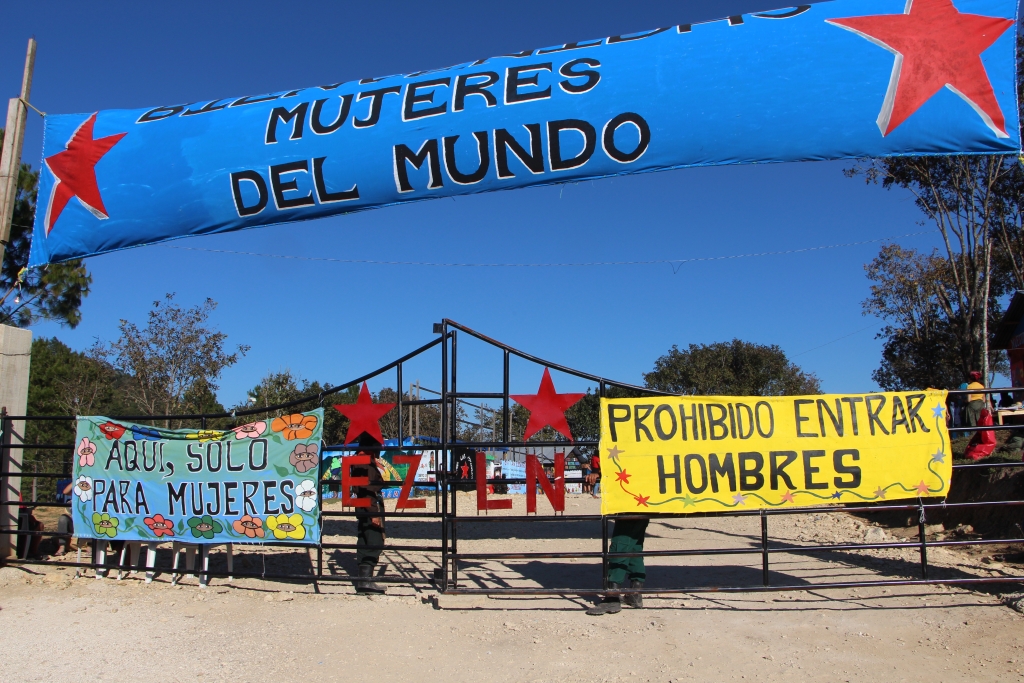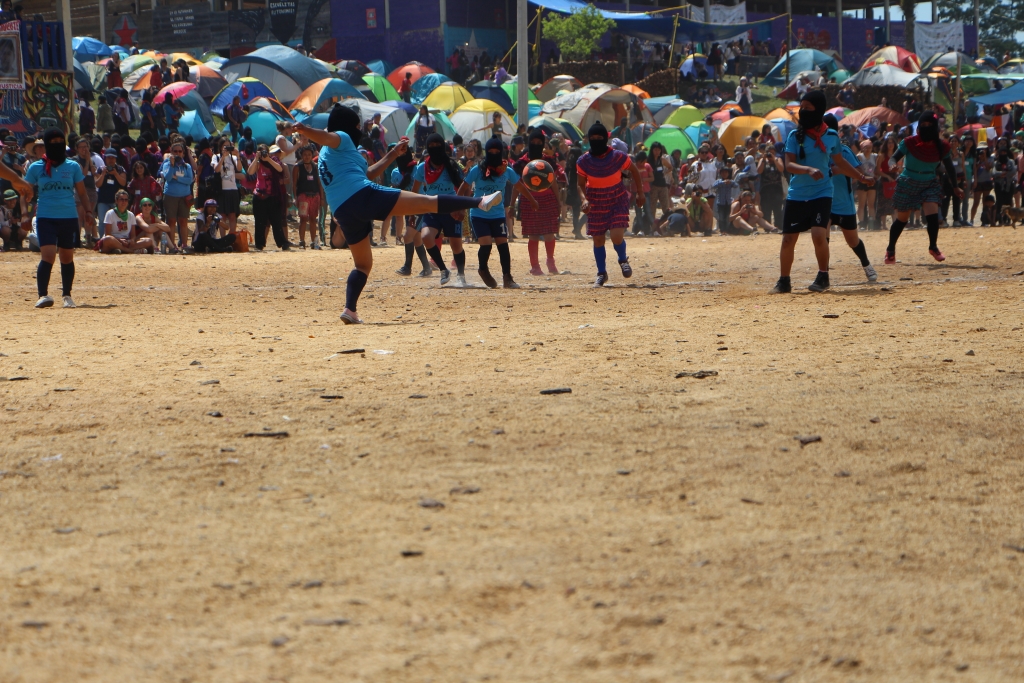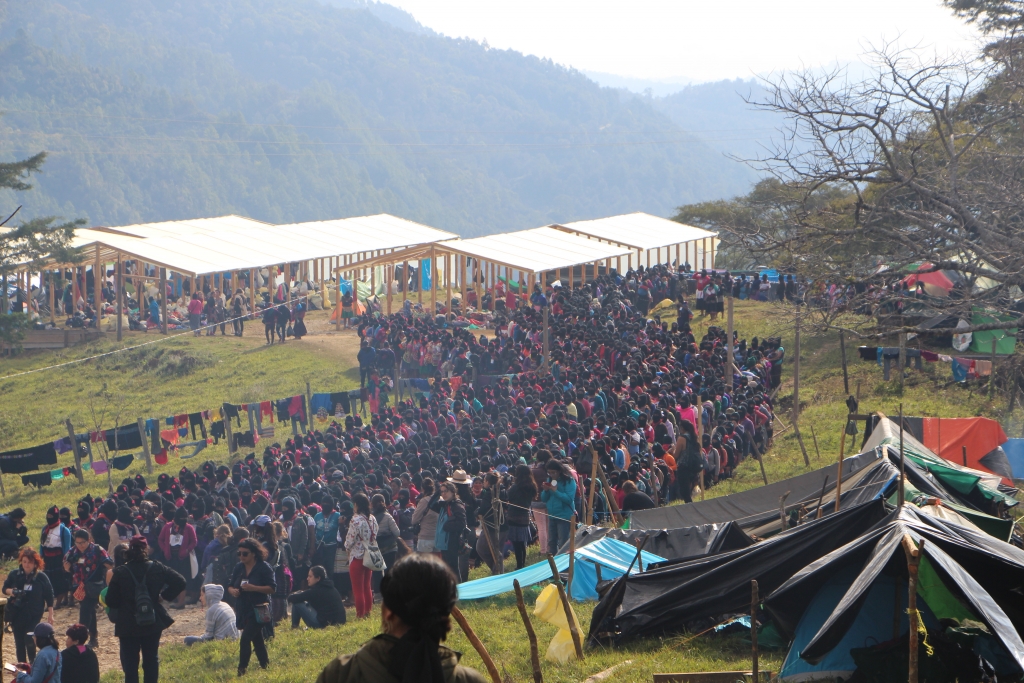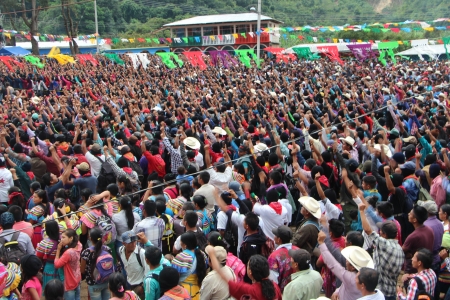What Does it Mean to Live? Notes from the Zapatistas’ First International Gathering for Women in Struggle
Publicado en español en Rebelión.
By the Kilombo Women’s Delegation**
First published at Viewpoint Magazine

Far from mainstream media coverage but at the heart of the autonomous organization of women’s struggle on the continent, the First International Gathering of Politics, Art, Sport, and Culture for Women in Struggle was held in Zapatista territory, Chiapas, Mexico, from March 8-10, 2018. Convoked by the women of the Zapatista Army for National Liberation (EZLN) and in what turned out to be an event of unexpected and unprecedented size, between 5,000 and 8,000 women, including trans people, from more than 50 countries traveled to the Zapatista caracol [center of autonomous government] of Morelia, joining some 2,000 Zapatista women for three days of events. For the first time ever at a Zapatista gathering, only women were permitted inside the caracol while accompanying men (and boys over 12 years of age) camped in the parking lot until the formal closure of the event on the third day.
The gathering celebrated International Women’s Day (March 8) and marked a context of accelerating violence against women, which has intensified in Mexico alongside the “War on Drugs.” Victims of that “war” continue to mount: by 2015 the official count (likely severely under-estimated) had reached 200,000 dead and over 30,000 disappeared, to which we must add some 1.65 million internally displaced, and 2017 went down as the most violent year since the drug war began. Mexico moved into the top 10 countries worldwide for firearm murders categorized as femicides, with rates in some states at 15 times the global average.As with other violent crimes in Mexico, impunity for femicide hovers above 95% and many crimes against women are passed off as domestic issues or women’s own fault.[i]It is in this context that the Zapatista women proposed that the first agreement to be made at the gathering should be “to continue to live and to struggle.”[ii]
The scope of the organizing effort required for such a gathering is difficult to capture: infrastructure for lodging, bathrooms, showers, food, and transport for thousands of women in the mountainous countryside; security provided by the presence of hundreds of unarmed but impeccably organized milicianas[Zapatista women civilian reserves]; the organization of Zapatista health teams, doctors, and an ambulance on standby for emergencies; the unfailing and attentive presence of a delegation of Zapatista women in each of the hundreds of workshops and activities offered by their guests; and dozens of “Tercios Compas,” the Zapatista media teams—again, all women—running a sophisticated technology platform across multiple stages and dozens of simultaneous events. In addition to this organizational feat, the Zapatista women provided a theoretical framework for women’s struggle that is striking in its historical and analytical depth and, it is important to note, not necessarily shared by many of the non-Zapatista women present. But the Zapatistas were clear about their purpose: this was not a gathering for women in general, but for women in struggle. As they said during the opening events, “We didn’t hold this event so rich women could come boss us around.” The lessons demonstrated by the Zapatista women throughout the event are too profound and numerous to summarize, but as women delegated by Kilombo to attend the event on behalf of our larger community, we want to summarize a few things that we learned and that we think could be helpful to women’s struggle across the world.

Women’s Freedom: Self-expression or Collective Self-organization
As the mountains around Morelia began to echo with women’s voices, music, and the sounds of basketball and soccer games, there was a tangible excitement to being part of such an enormous crowd with such a diverse range of activities coordinated across the caracol. Within this diversity, what immediately struck our delegation was that many of the workshops proposed and led by non-Zapatista attendees were focused on struggle understood as challenging the limitations imposed on self-expression and the individual female body. These workshops involved, on one hand, a wide variety of ways of using movement, voie, and art in order to heal, honor, or express oneself, and on the other, topics that address (what presenters imagine to be) the realities of the female body including reproductive rights and experiences as well as corporal self-knowledge and self-care.[iii]While many of these themes certainly must have a central place in any women’s struggle, we were concerned by the fact that the sheer number of presentations in this vein came at the expense of struggle understood as a question of structural social transformation. That is, self-expression seemed to come at the expense of questions of collective self-organization, “biological reality” at the expense of political strategy. Please note that we are not saying that these are mutually exclusive emphases; on the contrary, exactly what we want to point out is that it seemed that in the presentations of many attendees, self-expression and the body appeared entirely divorced from the questions of collective self-organization and structural transformation.
We think the risk in focusing on forms of individual expression is that they can easily remain within the realm of a cathartic and ephemeral release, and that this can stand in for the long, arduous process of building alternatives to a capitalist system that has proven itself adept at accommodating and even manufacturing these forms of release. Think here of the explosion of the self-care industry, yoga, new-age spirituality, and other appropriations of Eastern meditative practices that place a focus on the body and spirit and that in the context of contemporary capitalism only help recuperate us for another day of work. In other words, in this context, practices that might prepare us for struggle and liberation are easily assimilated, increasing our productivity and making us more enthusiastic and flexible participants in our own exploitation. The same could be said for forms of protest that allow for a release of collective energy but leave us little or nothing the day after, except perhaps a new aesthetic of rebellion.
Secondly, we think the risk inherent in the focus on corporal self-knowledge and self-care is that it can delink the necessary understanding and defense of our bodies from the structures that impose corporal controls on us in the first place and mask the reasons why the struggle over “the body” is so central to a project of emancipation to begin with. Here it is helpful to remember that capitalism has made control over women’s bodies compulsory in order to reproduce itself on whatever terms necessary for the system at a given time, whether that is obligatory procreation, forced sterilization, coerced reproduction to produce workers, postponed reproduction in order to work, or generalized sexual objectification. But reclaiming our bodies in this context is not about gaining control over our individual bodies—that particular understanding has only led us into a reality where some women in some places have been able to gain substantial control over their bodies and reproductive choices, while other women’s bodies are ravaged by poverty, police repression, overwork, and the vulnerability to violence that accompanies a life lacking in resources. This includes those who have had to give up control over their own reproductive life and domestic sphere in order to perform waged labor in someone else’s.
Therefore, while we do not discount the importance of the forms of corporal expression mentioned above, we do think that it is important to recognize that given the total social fragmentation brought by capitalist relations and values, there is very little hope for redemption of the individual body without the construction of a collective body willing to fight for its freedom. Without this protracted process of collective organization, we remain embattled on the terrain of the individual as produced by the system, rather than moving the struggle to a collective terrain where we can begin to create new people with desires and needs far richer than those available to individuals in the current system.
Freedom According to the Zapatistas: From Subjugation to Self-government
It was exactly this creation of new individuals through the process of collective organization that was highlighted in each speech, song, theater piece, and work of art presented by Zapatista women from each of the five zones of Zapatista territory. They began by theorizing the triple oppression they experience under the capitalist system for being poor, being indigenous, and being women, giving a multi-generational account of the indigenous history of colonization, slavery, violence, rape, forced labor, forced marriage, military harassment, and many other forms of violence and repression. It was this context that framed their emphasis on a particular point, articulated most explicitly by Insurgenta Erika who was charged with speaking on behalf of all the Zapatista women at the opening ceremony: “The struggle for our freedom as Zapatista women is ours. It’s not the job of men or the system to give us our freedom. On the contrary, the work of the patriarchal capitalist system is to keep us in submission. If we want to be free, we have to conquer our freedom ourselves, as women.”[iv]With this statement the Zapatistas are not claiming, as we will discuss below, that patriarchy is a concern only for women. Rather, what they are highlighting here is their conviction that nothing other than the actions of the oppressed themselves have ever or will ever move us toward liberation. Building on this point, each of the presentations that followed then laid out their struggle as the EZLN, and as women of the EZLN, to organize themselves and to build a series of autonomous institutions on recuperated lands that would allow them to take collective control over their lives. Here we want to take a step back to look at the creation of that collective, politicized terrain through the history of women’s struggle in the EZLN.
In 1993, on the eve of the Zapatista uprising when the Women’s Revolutionary Law was made public in the EZLN’s first publication, El Despertador Mexicano,[v]it had already been passed and adopted by consensus across the EZLN ranks and by all their community assemblies. The law outlined women’s rights to participate in struggle and hold positions of authority, to choose their partners and control their own reproductive health, to access healthcare and education, and to hold the same rights and responsibilities as men under revolutionary law.[vi]This framework for women’s rights and role in struggle throughout Zapatista territory reflected the immense organizational work already undertaken by women to create, educate about, and decide upon such a radical shift across a broad social base.
A mere 10 years later, in 2003, the EZLN announced the creation of five caracolesto be the political homes for the newly formed Juntas de Buen Gobierno [Good Government Councils] that would provide a third, zone-wide level of self-government for the Zapatista communities and autonomous municipalities. At this time, despite lacking full integration of women into these self-governing bodies,[vii]it became clear that the EZLN had already achieved an internal revolution of its own: the construction and institution of a community-based, self-governing civilian authority over the rebel army and throughout Zapatista territory, a victory not of women over men in the limited framework of gender, but of the values of community self-organization and collective self-government over the traditionally masculinist forms of dominance by force and military hierarchy.
Ten years later again, in 2013, the EZLN held the legendary Zapatista Little School in which over 7,000 students from all over the world attended a course given by the EZLN communities themselves under the title “Freedom According to the Zapatistas.”[viii]One of the four Zapatista textbooks published as part of the course, Women’s Participation in Autonomous Government, documented through the Zapatista women’s own accounts their widespread and advanced participation at all three levels of self-government and in the autonomous education and health systems, economic independence built through women’s cooperatives, transformation of the family and social spheres to allow for these shifts in women’s role; and the transformative growth of each of these community institutions to make good health, literacy, political experience, and organizational leadership standard aspects of women’s daily lives.
And then, just five years later and exactly a quarter century after the publication of the Women’s Revolutionary Law, the Zapatista women coordinated across all five zones of Zapatista territory to hold this historic International Gathering for Women in Struggle, demonstrating not just that unparalleled Zapatista power of convocation, but a profound analytical and organizational capacity across the social base (and military ranks) of women in the movement. This is something, they explained, that no one else could grant them nor take away from them, “not god, not man, not a political party, not a savior, not a leader, not a woman leader nor a female boss.”[ix]
In effect, Zapatista women went from practical slavery under the control of colonial and domestic masters and into the rule of their own Women’s Revolutionary Law and positions within the highest bodies of collective autonomous authority in a matter of decades. It is clear from this history that Zapatista women’s struggle (including the ban on drugs and alcohol in Zapatista territory) has brought about extraordinary, although of course uneven, advances in the protection of women from physical abuse, rape, and other forms of violence. But we think that the Zapatista women have also made clear that these advances were made possible not through avenues of individual expression and protection, but through the struggle to transform their concrete material conditions—in land use, food production, health, education, and conflict resolution—a transformation both generated by and generative of an understanding of self-organization and self-government so deeply socialized across the community base and collective consciousness that it gives rise to unique and constantly evolving forms of practice. Thus, the integrity and strength of any one Zapatista woman reflects the collective organization of all Zapatista women to struggle against the social order of capitalism that structures violence, inequality, and indignity into every aspect of our lives, from the most intimate sphere to the most global one.
Is Patriarchy a Women’s Issue?
If on one hand the Zapatista women insisted that women’s freedom is women’s job to conquer collectively, they also repeatedly emphasized, in presentations by women from each zone, that their struggle was not against men but against the system. Insurgenta Erika, again speaking for the intergenerational collective of Zapatista women, elaborated, “You should know that it wasn’t always men who exploited me, robbed me, humiliated me, beat me, scorned me, and murdered me. Often it was women. And it still is.”[x]In this sense, while the Zapatista women critique and counter sexist and patriarchal practices at every level of their resistance, their thought and actions help us to see the limitations of those forms of feminism where the imaginary of struggle does not go beyond the displacement of men and the desire to take their place. In other words, they don’t confuse overturning their own oppression with upward mobility within the given relations of domination.
We think that in the Zapatista framework there is an understanding of patriarchy not as a women’s issue or a men’s issue, or even primarily as a gender issue, but rather as a systemic form of domination and inequality that structures all social relations and licenses the domination of men over women, but also of men over other men and women over other women. Here we think it is important to note the parallels between the way that the Zapatista women understand women’s struggle and the struggle of Kurdish women within the Kurdish freedom movement.[xi]In these frameworks, we can see that excising systemic problems as women’s issues is merely a marginalization of the issues that marginalize women. The fact that patriarchy teaches men that their self-worth is tied up in their ability to exercise (and inevitably experience) domination certainly damages women but also debilitates men and society as a whole, corroding from the outset one’s external ability to create relationships of non-domination and one’s internal ability to participate in a project of thinking and organizing with others. The politics of collective self-organization we are discussing here is so challenging to many men (but not only men) that they can perceive it as self-destruction rather than a social reorganization that could force all of us out of the roles of dominating or being dominated imposed by the capitalist system. We desperately need a politics that destroys these roles rather than rearranging them. Here we see how Zapatista women’s struggle can simultaneously articulate the triple oppression they suffer under patriarchal capitalism—as poor, as indigenous, and as women—and at the same time recognize that freedom from such oppression is not specific to women.
Which body?
At the end of the encounter, the Zapatista women put forward three proposals.[xii]First, they proposed that as women we continue to live and to struggle; this was met with enthusiastic applause and agreement. They then proposed that, due to the fact that not all the women present were in agreement that women’s struggle is against the capitalist system, each woman return home to her collective to study, analyze, discuss, and determine whether it is in fact this system that is responsible for women’s oppression. This proposal received more solemn applause. Finally, the Zapatista women proposed another women’s gathering to be held next year (enthusiastic applause), adding that this gathering should take place not just in Zapatista territory (considerably less applause), but in each place from which the women present came. This third proposal was not just a suggestion to multiply the event, but one tightly woven into the second: the necessity for organized collective bodies that can discuss and determine the cause and form of our subjugation and thus the path and strategy of our struggle. The Zapatista women had just walked us through their own process of doing this, something that for them included an aspect of technical illiteracy—of need to learn to read and write and to speak Spanish in order to participate in a collective struggle across multiple languages. What they are proposing to others is perhaps the much bigger challenge of overcoming a kind of social illiteracy—of needing to learn to think, analyze, discuss, and decide together over our lives.
It seems to us, and the Zapatistas themselves have pointed out,[xiii]that it is only through this possibility of building a collective—and building a collective analysis—that one can gain a sense of self and therefore orientation on a path of struggle. But in the current system we are offered only weak substitutes for that sense of self. We have been sold many forms of “freeing” ourselves from oppressive conditions that necessarily pass through the process of becoming somebody—of achieving recognition or a place in the limelight. These are enticing forms precisely because so many women and others have been silenced in or erased from our collective consciousness and memory. But those places and lights are not only increasingly fleeting but largely circumscribed and proscribed by and for the system itself. Neoliberal capitalism offers no shortage of opportunities for individual recognition and self-promotion disguised as freedom, and in our current context the result is an abundance of “movement leaders” with social media presence but no community base and performative acts of “opposition” without practical consequence, both of which can be attention-grabbing in the immediate but lack the serious, sometimes tedious, ongoing and unrecognized processes of collective organization and personal sacrifice that by necessity constitute struggle. We think the Zapatistas are showing us a process of becoming, all together, nobody, of creating a largely invisible and mostly anonymous social power from below with a far more profound response to exploitation, dispossession, repression, and humiliation than the symbolic and select somebodies permitted by capitalist structures. In the EZLN’s words, “when the powerful refer to others, they disdainfully call them ‘nobody.’ But ‘nobody’ makes up the majority of the planet.”[xiv]
We must of course protect and respect the individual bodies—women’s and men’s—that are violated in so many different ways through the absurd horrors of the capitalist system. But in that effort the only body that can free us is the social body, constituted by those anonymous acts of collective self-organization capable of birthing a new way of life. Women’s struggle, then, is not a fight for recognition, access, or inclusion in existing structures; it’s an insistence on fighting for a world where neither social relations nor material production are based in the false hierarchies and decaying institutions of the capitalist system. In that sense, as the Zapatista tale goes, “in the world to be made, in contrast to the current one and those that came before and whose creation is attributed to various gods, when someone asks, ‘who made this world?’ the answer will be, ‘nobody.’”[xv]
On that day that will be night
As dusk set in on the first day’s events, we noticed Zapatista women moving in organized lines through various parts of the caracol, though in the falling darkness it was hard to make out their ultimate formation. At the end of the evening, they called for a moment of silence for Eloísa Vega Castro, a member of the Baja California support team for the Indigenous Governing Council who was killed in a car accident while accompanying the Council and its spokeswoman, María de Jesús Patricio Martínez, on a tour of that state on February 14, 2018. Across the chilly, starlit mountain valley, the lights went out and two thousand candles went up, held by all of the Zapatista women who had formed, as of almost two hours before, a great ring around the central plaza of the caracol. What clearer expression could there be of solidarity in struggle than thousands of organized Zapatista women encircling with all of their discipline, tenderness, and tenacity the thousands more women they had invited to their territory and raising all those tiny flames in memory of another. At the close of the gathering, they offered another message for that moment, in the voice of Zapatista compañera Alejandra, worth citing at length:
“On March 8, at the end of our contribution, each of us lit a small flame. […] That small light is for you. Take it, sister, compañera.
When you feel alone.
When you are afraid.
When you feel that the struggle is very hard; when life itself is very hard.
Light it anew in your heart, in your thoughts, in your gut.
And don’t just keep it to yourself, compañera, sister.
Take it to disappeared women.
Take it to murdered women.
Take it to incarcerated women.
Take it to women who have been raped.
Take it to women who have been beaten.
Take it to women who have been assaulted.
Take it to women who have been subjected to all kinds of violence.
Take it to migrant women.
Take it to exploited women.
Take it to deceased women.
Take it and tell each and every one of them that she is not alone and that you are going to struggle for her; that you are going to struggle for the truth and justice that her pain deserves; that you are going to struggle so that the pain she carries will not be repeated in another woman from any world.
Take it and turn it into rage, courage, and determination.
Take it and unite it with other lights.
Take it and, perhaps, you will come to think that there can be neither justice, truth, nor freedom in the patriarchal capitalist system.
Then, perhaps, we can meet again to set fire to the system.
And perhaps you will be beside us ensuring that no one puts out that fire until only ashes are left.
And then, sister and compañera, on that day that will be night, perhaps we will be able to say together with you:
‘All right, yes, now we are really going to begin building the world we need and deserve.’”[xvi]
[i]For the data cited here as well as additional statistics, see David Agren, “Mexico maelstrom: how the drug violence got so bad,” The Guardian, December 26, 2017; Arturo Conde, “In Mexico, Grieving Parents Call for End to Drug Wars, Legalization,” NBC News, April 26, 2016; BBC Monitoring, “Mexico’s war on drugs: Arrests fail to drive down violence,” January 25, 2018; Agence France-Presse, “Officials: 2017 was Mexico’s most violent year in two decades,” December 23, 2017; David James Cantor, “The New Wave: Forced Displacement Caused by Organized Crime in Central American and Mexico,” Refugee Survey Quarterly, Vol. 33, No. 3, pp. 34–68;The Geneva Declaration on Armed Violence and Development: “Global Burden of Armed Violence 2015: Every Body Counts,” May 8, 2015; reports from the Mexican Statistical Institute [INEGI] as reported in Telesur, “State of Mexico Issues Emergency Alert Over Gender Violence,” July 9, 2015; and information from Mexico’s National Women’s Institute and the UN Women Agency as reported by The Guardian, “Mexico: murders of women rise sharply as drug war intensifies,” December 14, 2017.
[ii]EZLN. March 8, 2018. “Zapatista Women’s Opening Address at the First International Gathering of Politics, Art, Sport, and Culture for Women in Struggle.”
[iii]For the preliminary list of the workshops proposed by attendees, see this report from the support teamfor the organization of the gathering.
[iv]EZLN. March 8, 2018. “Zapatista Women’s Opening Address at the First International Gathering of Politics, Art, Sport, and Culture for Women in Struggle.”
[v]For digitized content of the initial El Despertador Mexicano, see the EZLN archive.
[vi]EZLN. Women’s Revolutionary Law.
[vii]EZLN. August 21, 2004, “Leer un video Segunda parte: Dos fallas”
[viii]For information on the Zapatista Little School, see the EZLN’s text from March 2013, “Dates and other Details for the Little Zapatista School.”
[ix]EZLN. March 8, 2018. “Zapatista Women’s Opening Address at the First International Gathering of Politics, Art, Sport, and Culture for Women in Struggle.”
[x]EZLN. March 8, 2018. “Zapatista Women’s Opening Address at the First International Gathering of Politics, Art, Sport, and Culture for Women in Struggle.”
[xi]Here we recommend, for example: Abdullah Öcalan, The Political Thought of Abdullah Öcalan: Kurdistan, Woman’s Revolution and Democratic Confederalism. Pluto Press 2017; and Brecht Nevenand Marlene Schäfers, “Jineology: from women’s struggles to social liberation.” ROAR Magazine, November 25, 2017.
[xii]EZLN. March 10, 2018. “Words of the Zapatista women at the closing ceremony of the First International Gathering of Politics, Art, Sport, and Culture for Women in Struggle in the Zapatista Caracol of the Tzotz Choj Zone.”
[xiii]El Kilombo. 2009. Beyond Resistance, Everything: An Interview with Subcomandante Insurgente Marcos.
[xiv]EZLN. March 1, 2003. “Otra Geografia.”
[xv]EZLN. March 1, 2003. “Otra Geografia.”
[xvi]EZLN. March 10, 2018. “Words of the Zapatista women at the closing ceremony of the First International Gathering of Politics, Art, Sport, and Culture for Women in Struggle in the Zapatista Caracol of the Tzotz Choj Zone,” (emphasis ours).

**The Kilombo Women’s Delegation attended the Women’s Gathering in representation of El Kilombo, a community political project in North Carolina dedicated to building counter-institutions to meet our needs for material survival, study and analysis, and a healthy and vibrant community life. You can contact them at elkilombo@riseup.net.


 Interview with Alvaro Reyes (the Workshop for Intercommunal Study)
Interview with Alvaro Reyes (the Workshop for Intercommunal Study)